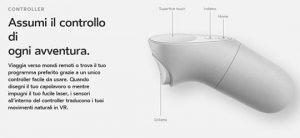Cospaces and how the UX change with the new Oculus Go support
Just a few days ago, a Cospaces update added, among other improvements, for the first time the support of Oculus Go, the Facebook all-in-one virtual reality viewer.
This novelty, together with the new CoBlocks programming language, subject of another post, can be a real game-changer for the project. Let’s take a quick look at the highlights …
So far Cospaces used the Google Cardboard platform, inheriting the same graphic and interactive opportunities, including its limits. In particular, the overlap (‘Hover’) and selection (‘Activate’) events were constrained to the point in the center of the visual field, and highlighted by the application as a small circle able to increase slightly in size to its “passage” above objects when an event had been planned.

In other words, according to the Cardboard style, pointing at an object within the VR mode environment is only possible by turning the head to “frame” the object in the center of the visual field.
With the support of the new Oculus Go instead, the pointing of an object is managed by the remote controller, the joystick, supplied with the visor itself. The main advantage is the possibility of selecting an object without being in the center of our field of view. Now objects at the sides of the screen can be selected, for example to perform specific actions.

Think about exploration games where you can collect objects that you can use elsewhere in the virtual world to perform actions: you answer a few questions and receive a key, and use it to open a door in another room. Or think about contextual menus always present on the screen, as if they were superimposed.
The other side of the coin is the loss of those characteristics of universality and ease of access that had made the Cardboard solution a winner. Now it is not enough to use a personal smartphone in a cheap cardboard, but you need a specific device, the Oculus Go, that can only be used for this purpose.
What to privilege? Which platform, in the experience of concrete and real use in classes and homes, will respond better to teachers’ and students’ needs?
In the next days we will perform specific tests of comparison between the two platforms…
See you soon!
